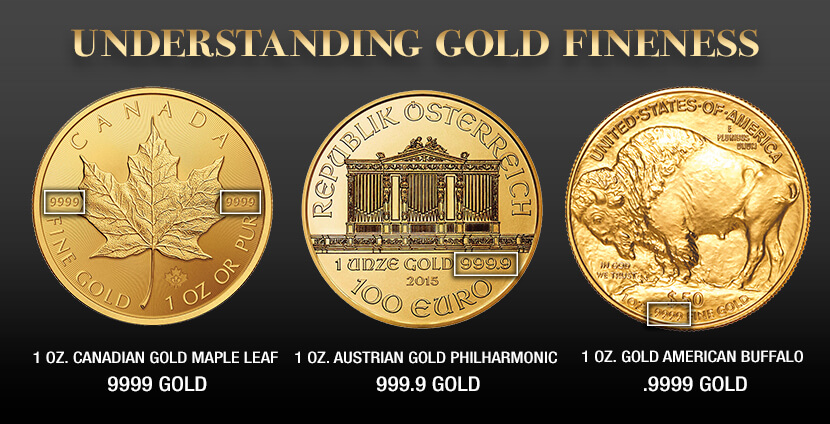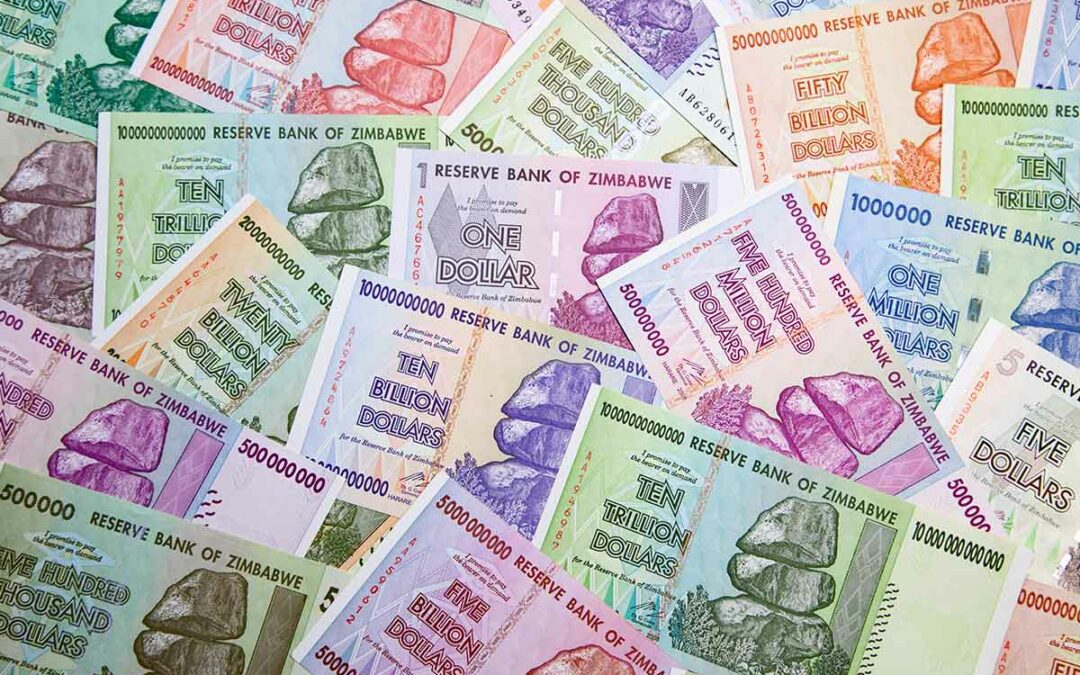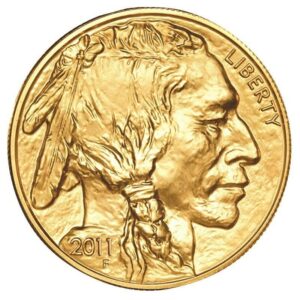In the precious metals world, karat is an important way of expressing the purity of gold.
But it isn’t the only way. There’s also fineness (sometimes called millesimal fineness), which conveys the precious metal content of gold in parts per thousand. For instance, a fineness of 750 translates to 75% gold, or 18k. You will also see fineness expressed as a decimal or percentage.
The following is an example of how three different countries and their national mints express gold fineness on some of the most popular 24k gold coins: the Canadian Gold Maple Leaf, Austrian Gold Philharmonic, and the Gold American Buffalo. Each of these coins has the same fineness, just expressed in slightly different ways.

A quick note on “nines.” See how each coin has four nines? This is sometimes called “four nines fine,” and it's the most common fineness for 24k gold coins. A gold coin can, however, have five or six nines, but it's much less common. “Five nines fine,” or 999.99, is the purest gold ever produced. In 1998, the Royal Canadian Mint was the first to reach “five nines” purity levels. The Perth Mint achieved “arguably the purest of all gold” in 1957 when Refinery Officer Leo Hickey and Senior Craftsman Alexander Osborne produced a proof ‘plate' of almost six nines—999.999 parts of gold per thousand.
Gold Fineness vs. Karats
Since the definition of fineness is a measure of the precious metal content of gold in parts per thousand, many precious metals buyers find value in understanding the precise composition of the gold to which a particular fineness rating refers.
For example, 22 karats of gold (22k) has a gold fineness of 917, which can also be expressed as 91.7% of gold with an alloy mixture of 5% silver, 2% copper, and 1.3% zinc. To some precious metals buyers, it’s the kind of breakdown that offers an easy-to-understand line-item overview of a gold coin’s composition.
| Karats | Gold Purity | Fineness | Alloy Mixture |
| 10k | .417 | 417 | Gold: 41.7%
Other Metals: 58.3% |
| 12k | .500 | 500 | Gold: 50%
Other Metals: 50% |
| 14k | .583 | 583 | Gold: 58.3%
Silver: 25% Copper: 17% |
| 18k | .750 | 750 | Gold: 75%
Silver: 15% Copper: 10% |
| 22k | .917 | 917 | Gold: 91.7%
Silver: 5% Copper: 2% Zinc: 1.3% |
Alloy Allies
The alloys mentioned in the fineness chart above are added to gold to provide much-needed firmness. Here’s why: gold that is 100% pure is also 100% impractical. It’s so soft that you could easily mold it with your hands.
Most gold alloys combine gold, copper, and silver. The highest available purity is 24 karat gold—99.99% gold—with alloys comprising the difference and providing much-needed solidity. The Gold American Buffalo, Austrian Gold Philharmonic, and Canadian Gold Maple Leaf are all examples of 99.99% pure gold coins.
In the U.S., 24 karat gold is generally reserved for gold coins and bars, not jewelry. Why is this? According to The Diamond Pro, 14k gold is the most popular purity for wearable gold jewelry because 24k is:
- Incredibly soft, making it easy to bend and scratch.
- Very bright and orangey, which are characteristics that many gold jewelry buyers find unappealing.
- Less affordable than jewelry of other purities, which can reduce the number of potential buyers.
Fineness Forever?
Fineness remains a popular way to measure gold content; however, “karat” is still the most conversational and common way to talk about gold purity. “Karat” is also the term people use most often when searching for gold products online.
Measurements of fineness still linger for a few reasons, including:
- The growth of the bullion industry
- The use of decimalization in worldwide currencies
- The metric system’s popularity in Europe
So, while it’s good to understand the difference between karat and fineness, understanding karats—such as the difference between 24 karat gold, 18 karat gold, and everything between—is information best retained for the foreseeable future.
Just beware of confusing “karat” with “carat.” Carat with a “c” is a measurement of weight for gemstones. What is a karat? Karat with a “k” is a measurement of gold purity; it’s short for “karatage.” Some countries use the two words interchangeably, but “karat” is the correct word for discussing gold purity in American English.
Determining Quality…
Wondering how gold purity can be determined if alloys are mixed in? There are several ways, including tests that use nitric acid and X-ray fluorescence—two tests that are best left in the hands of professionals. Since a nitric acid test involves damaging the gold, devices that utilize X-ray fluorescence offer a safer and highly accurate alternative.
There are a few easier ways for you or anyone who appreciates precious metals to learn about a piece’s purity:
- Find the purity stamped or laser-etched on the gold piece in question. With a gold coin, the purity is often stamped along the outer portion of a coin’s face. With gold bars, you’ll often find it clearly noted on each bar’s front.
- Use a magnifying glass to inspect your gold coin or bar for color, shininess, and the gold purity mark if you can't see it with your naked eye.
- Rely on trusted companies like U.S. Money Reserve for any precious metals or gold purchases.
… and Finding Quality
U.S. Money Reserve specializes in selling U.S. government-issued gold coins, which are guaranteed for their gold content, weight, and purity. That means there's little need to investigate on your own. Gold American Eagles and Gold American Buffalos are two such coins. The U.S. government's guarantee means that you can be sure these gold coins contain the stated amount of actual gold in troy ounces: .9167 gold and .9999 gold.
Want to maximize the gold purity and power of your precious metals portfolio? Call U.S. Money Reserve, America's Gold Authority®, to learn how to buy the highest quality gold you can afford.

![Buying-Gold_830x554[4] Buying Gold: What to Know About the Difference Between Karats and Fineness](https://www.usmoneyreserve.com/wp-content/uploads/2019/04/Buying-Gold_830x5544.jpg)






